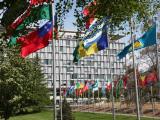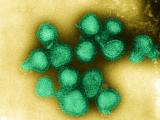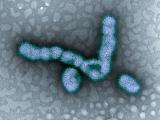Jan 25, 2008 (CIDRAP News) – The authors of a 2007 study of nonpharmaceutical measures used in the 1918 influenza pandemic, responding to a critique from historian John M. Barry, argued last week that there is strong evidence that New York City used isolation and quarantine to battle the Spanish flu.
In a study published in August, Dr. Howard Markel and colleagues said their analysis of historical records from 43 US cities indicated that the early use of nonpharmaceutical interventions (NPIs), such as isolating the sick and banning public gatherings, saved lives in the 1918-19 pandemic.
Their study, which appeared in the Aug 8 Journal of the American Medical Association, had a major influence on the Centers for Disease Control and Prevention's (CDC's) recommendations early in 2007 for the early, targeted use of NPIs in a flu pandemic. Two of the authors, including senior author Dr. Martin Cetron, work at the CDC Division of Global Migration and Quarantine.
In a letter published in JAMA in November, John M. Barry, author of the 2004 book The Great Influenza, rejected the finding of Markel et al that New York City used isolation and quarantine to combat the epidemic. He argued that the evidence about events in New York City does not support the authors' view that NPIs were effective n 1918. Markel and colleagues responded with a letter in the same issue of JAMA.
Subsequently, Barry presented his critique in much more detail in a commentary published by CIDRAP News on Nov 27 (see link below). He questioned Markel's findings concerning not only New York City but also Chicago.
Last week, with no fanfare, the CDC's Division of Global Migration and Quarantine published a detailed online response to Barry's critique. The response's authors are not listed, but the presentation and referencing indicate it was written by the JAMA article authors. The response does not specifically mention Barry, referring only to "assertions made on the Internet."
Barry's argument
The response by Markel et al is best understood in the context of Barry's critique. His main points were as follows:
- None of the New York City Department of Health's official records, including board meeting minutes, from the pandemic period mention the use of quarantine.
- In looking for evidence of isolation and quarantine in New York City, Markel et al relied heavily on statements by City Health Commissioner Royal Copeland. Copeland was a homeopath, not a medical doctor, and was appointed by the city's Democratic political machine, Tammany Hall, which had a record of putting unqualified loyalists in city jobs.
- In separate speeches to private physicians that were reprinted in the New York Medical Journal in October 1918, Copeland and his deputy, Louis Harris, head of the city's Bureau of Preventable Diseases, gave a long list of actions taken to battle the flu epidemic (and some not taken), but neither mentioned isolation and quarantine. Copeland said that even were it possible "to confine every person to his or her home, it is doubtful whether the epidemic could be measurably diminished."
- In statements to the New York Times, Copeland might have talked about a New York quarantine just to make the city look better in the face of reports that Jersey City was using quarantine.
- Concerning NPIs in Chicago, the JAMA study said the city took its first action on day minus-2, ie, 2 days before the mortality rate exceeded double the baseline rate. But (Barry wrote) at that point the city only banned public funerals, and it didn't use any major NPIs until 21 days later (day plus-19), when it banned public gatherings in general.
Quarantine orders taken seriously
In their response, Markel et al write that in 1918, quarantine was a complex concept with several meanings. "There is, unfortunately, no way to quantify with exact precision the level of public compliance with any of the NPI in any of the 43 cities in our study," they state. "When studying the broader context of epidemics of this era, however, the historical record suggests that when such public health orders were enacted, they were taken rather seriously, albeit not universally."
They go on to list various pieces of evidence that isolation and quarantine were practiced in New York City during the pandemic.
As their principal evidence, the authors point to the weekly minutes of the board of the city health department for Sep 17, 1918, when the group declared influenza (along with lobar and bronchial pneumonia) a reportable disease, the same as cholera, smallpox, and plague. The city's health code required the isolation and quarantine of those ill with the disease or suspected of having it.
The day after this declaration, the city notified all resident physicians of it by letter and reminded them of their responsibility to isolate and quarantine cases, the authors write.
Subsequently, "numerous articles in virtually every New York newspaper" reported the use of isolation and quarantine in the city, the authors continue. A footnote cites articles in the New York Herald, the Evening Journal, the Times, and the World.
Further, the CDC article says that directors of health department hospitals were worried about running out of beds in their isolation wards because of the influx of flu patients. As evidence for this, the authors cite a Sep 24, 1918, New York Times story in which Copeland said that if the epidemic grew any further, health department hospitals would run out of space and would have to call on general hospitals for help.
Also, the authors write that some private physicians in the city took the isolation and quarantine order so seriously that they placed homemade quarantine placards on the homes of flu patients. An endnote says that Copeland, in another statement to the New York Times, said that placarding by private physicians was not necessary, given that the city code required isolation or quarantine of patients.
Concerning the lack of mention of quarantine in the health department's annual report and other documents and in the speeches by Copeland and Harris, Markel et al assert that this "absence of evidence" does not equal "evidence of absence."
Interpreting Copeland's comments
The authors also reject the suggestion that Copeland spoke of a New York quarantine only because Jersey City had implemented a quarantine policy. They say this suggestion seems to have been inaccurately derived from a New York Times article that happened to report on the Jersey City quarantine immediately after mentioning New York's.
Further, the study authors say that in his comment about the futility of trying to fight the epidemic by confining every person at home, Copeland meant what he actually said, and was not talking only about isolation of patients and quarantine of contacts.
In an endnote, the authors discuss Copeland's political affiliation and training. They assert that his Tammany affiliation does not necessarily mean he was incompetent and that despite being a homeopathic physician, he was trained in and had a deep appreciation for allopathic medicine.
The study authors also reject Barry's suggestion that a possible reason for New York's and Chicago's relatively mild experiences in the 1918 pandemic was that many residents might have developed some immunity during the first wave of flu in the spring of 1918. Their study revealed no statistical associations between flu-related excess mortality rates in each city during the four successive waves of influenza from spring 1918 through the winter of 1920.
Regarding the Chicago experience, the authors said they reran their analysis using different dates for the initiation of NPIs and got essentially the same results. They changed the date marking the first NPI from Sep 26, when public funerals for flu patients were banned, to Oct 1, when isolation of flu patients was ordered. They also changed the date for the general ban on public gatherings to Oct 17. With these dates, the correlations of public health actions with excess death rates and total excess deaths remained about the same.
See also:
Commentary by the JAMA authors, published on the CDC Division of Global Migration and Quarantine site
http://www.cdc.gov/ncidod/dq/1918_commentary.htm
Commentary by author John M. Barry, published Nov 27, 2007, by CIDRAP News
http://www.cidrap.umn.edu/cidrap/content/influenza/panflu/news/nov2707barry.html
Abstract of Aug 8, 2007, JAMA report by Markel and colleagues: "Nonpharmaceutical interventions implemented by US cities during the 1981-1919 influenza pandemic"
Aug 13, 2007, CIDRAP News story "Study says nondrug measures helped in 1918 flu pandemic"



















